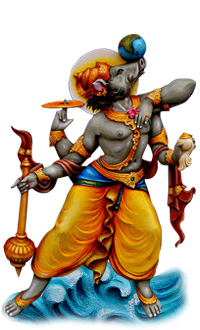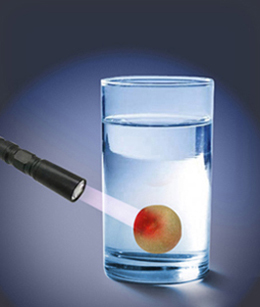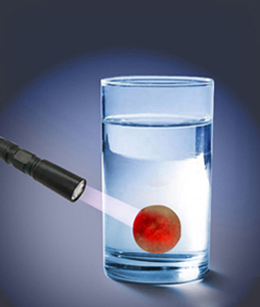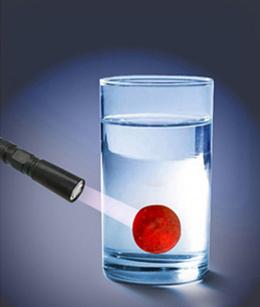Shopping Cart
0 item(s) - Rs 0.00/-Varaha Mani
1. Description of Varaha Mani or Boar Pearl. |
|||||||||||
 |
Varaha Mani/Pearl is a light brownish skin coloured pearl which resembles like a colour of potato peel, marble-sized sphere with uneven smooth surface. This Mani has a physical appearance like that of any organic substance. This Varaha Mani or Boar Pearl was found from Gandaki River at Muktinath Chettra at Nepal. He is partially translucent and apparently opaque at the first glance. Varaha Mani has a special characteristic which makes Him glow/illuminate/glitter when a light source is focused on this Mani. When illuminated with a focused light source this pearl will emit a deep red haze at a place where the light source is focused and as the light source is focused on the pearl/mani continuously, He slowly illuminates Himself completely with the red bright illuminated colour. The brightness and illuminating effect on this Mani last for quite some time even when the light source is removed. After some time He turns into his natural colour which is the colour of a potato peel as explained above. It is interesting to note that when the illuminated Mani is held in the hand, the temperature of the Mani remains at a room temperature and does not rise at all. He has exceedingly non-porous surface with an almost water-resistant texture. He contains two points each juxtaposed at a 90 degree angle around a single-plane, which appears to be a single fiber running through the diameter. The initial fiber points appear like a embedded grain of sand, but with careful observation under different light sources, the "grain" more closely resembles a single fiber optic strand that passes light through the gem body. Light weight and quite different in composition than When this Varaha Mani is dipped in a glass of water He settles down at the bottom of the glass. When a light source is focused from outside the glass on to this Mani, the Mani again starts illuminating very brightly with deep red colour. Initially at the point where the light is focused and subsequently all over the Mani. This implies that some very powerful energy is inside the Mani and though when illuminated the energy level rises but still being inside the water the energy level remains same as that of being outside the glass of water. |
||||||||||
|
|||||||||||
2. References to the Varaha Mani / Boar Pearl within sacred texts. Sri Garuda Puranam, Chapter LXIX (69) " Suta said: Varaha Mani / Pearls are found in the temples of wild boars.(the Varaha incarnation of Lord Vishnu). A Boar Pearl or Varaha Mani resembles the tip of its tusk in color (brownish colour), and is obtained in certain quarters of the globe and it is extremely blissful like the Lord Varaha which is the Boar incarnation of the divine Vishnu.” As per Garuda Purana the Holder of this rare Mani will be especially blessed with Varaha Avatara of Lord Vishnu. He is blessed with invincible power and kingly comforts and an ultimate place at Vaikuntha / attaining of Moksha. The devotee who has Varaha Mani will do Gau Seva, donate millions of cows to the Vaishnavas and do good for the masses. All this he will be able to do with the help of the Varaha Mani. 3. Theological alignment of a given pearl group (i.e. presiding deity is Varaha Dev, Lord Vishnu’s 3rd incarnation) Highly oriented to Lord Vishnu, who at an early stage took the form of the Wild Boar, Varaha, in terrestrial form. 4. Cosmological Inherent (i.e. gem of Heaven, Vaikuntha) Planetary gem, these Mani are "planetary gems" in the same sense as the terrestrial precious and semi-precious stones. Corollary research regarding variations of "planetary gem" subtleties would prove useful. 5. Religious or cultural significance of given pearl variety. Perceived to be a significant point of focus for worship to honor the Lord Vishnu, in the form of Lord Varaha, whom many Hindus (known as Vaishnavas) regard in a "One God" construct. The Boar Head pearl has a number of symbolic features as well, which additionally lend themselves in representation of Lord Vishnu. 6. Cross-references noted within Varaha mihira. "Very valuable and lustrous like the Sun is the pearl born of the root of the boar's tusks." In aggregate Varaha Mani or Boar Pearl... "He possess inestimable wealth / virtues or excellences, no price has been fixed for them by the authorities since it is invaluable and entire Earth’s wealth will less to buy this mystic Mani." Last Varaha Mani was traded at a virtue of 100 crores INR (Indian Rupees One hundred Crores). 7. Ritual handling of the artifact. Indicated worship is a weekly bathing ritual, flowers can be offered as well as incense at any time, in addition to dressing with aromatic oil. Puja on the Varaha Mani can be enhanced if the water used is from the Ganges River. The puja also becomes incrementally more powerful if the water poured is from a off white / white coloured Dakshinavarti Shankh, the right-handed preferably small Laxmi conch shell (small right handed conch are more rare as compared to big right handed conches). All water that is poured from such a sacred shell traditionally has the power to purify, to breaking curses, and to expel demons and evils as is common in other religious practice. Varaha Mani bestows the devotee with the kingly comforts, extreme power and achieving of Vaikuntha. An installation rite is not required for the Boar Head Pearl or Varaha Mani, however it is optional and may be self-performed (the preferred experience within Hinduism, as anyone else doing a ritual for you is less powerful), or done under the auspices of an experienced Hindu practitioner or a Hindu priest. 8. Stipulations regarding ownership. Very lucky devotee can have a chance to even see this mystic qualities of this Mani. The owner of this most valuable Mani is the one who has done lots of Punya in the previous births. This Mani will bestow several generations of the owner of this Pearl. 9. Geographical origin. Greater southeast Asia and the Indonesian archipelago 10. Scientific considerations for full overview. This is a very different kind of pearl. The single strand fiber points to a tissue nodule formation process, almost the shape of a large pill. 11. Archaeologist review. Fascinated, but without comment. 12. Hindu intelligence. The body of cultural information on the Boar Head pearl was conveyed preexistent to our study of this class of artifact. It was held that if these were real Boar Head Pearls, that one would look the red light emanating/ glowing/ glittering from the pearl when the light is focused on this pearl. Normally this pearl would be brownish in colour without any glow or glitter or any light. The light or glitter will be more visible in the darkness. The glitter on falling of light, however, was to be considered symbolic in origin, and represented a visual aspect within the Varaha (incarnation of Vishnu as a boar) creation story. When we were invited to an extensive puja ceremony with the Hindu priest, and he was quite vocal about the Boar Head Pearl, though he did not speak English and we required a translator. It was conveyed that that the pearl had a tremendous amount of energy and addressed the pearl within the ceremony with the purpose of driving the energy level even higher. We derived that the tradition of feeling subtle "energy" and immense “power” in Mani as a primary validation, typically considered a subjective "new age" approach, originated in Hindu tradition and is really not "new" at all. 13. Relative Scarcity of pearl. The translucent varieties are apparently the most rare, while ones more opaque are slightly more available. 14. Known Placements. Again, these are "very valuable" according to Varahamihira, but we consider this variety of Mani as exceptional from a number of measurable criteria. Last known Varaha Mani exchanged hands with Rs. 100 Crores INR. 16. Conjecture on what gives each pearl a Sacred property. Largely unknown. A high degree of concord, symbolic or otherwise, with the Lord Vishnu (who took earthly form as the boar Varaha) is inferred by the Boar Head Pearl. 17. Final determinants. The pearl suggests a biological process which aggregates deposits of utero ferrin, a red protein essential to the gestation and post-natal development in the boar family, in the head of certain older specimens. As the protein is found in everything from the placenta to the sperm of adult males, in increasing amounts over the life span of a boar, it is considered a reasonable argument that The Boar Pearl has multiple points of scientific validation as a wildlife by-product outside of strictly religious contexts. 18. Conclusions The Boar (Varaha) Pearl is extremely rare and if you can afford, don’t miss a genuine one. |
|||||||||||






 Head Office Address:
Head Office Address: Telephone:
Telephone: E-Mail Addresses:
E-Mail Addresses:




